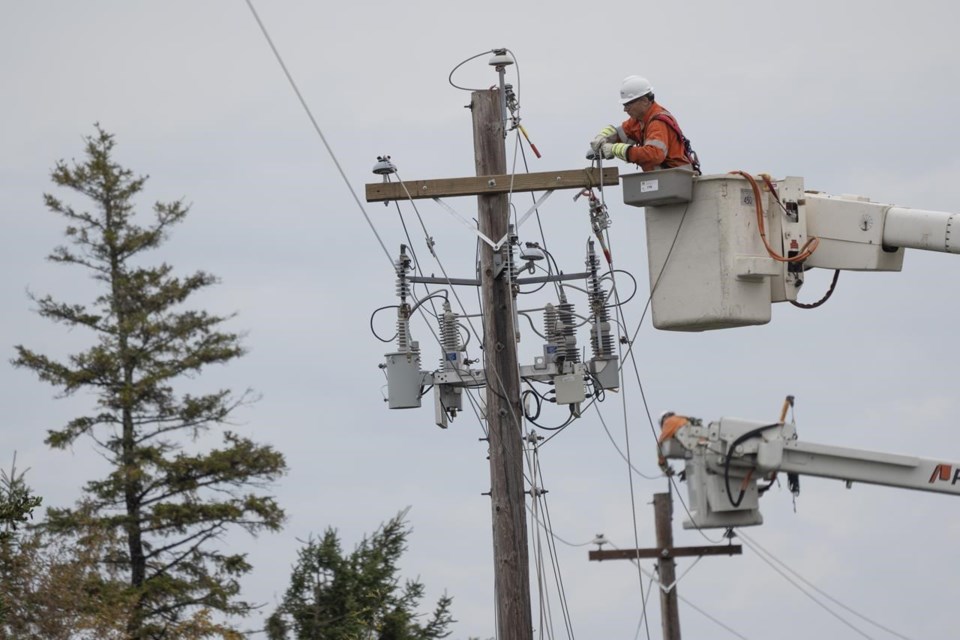HALIFAX — As Nova Scotia's electrical utility and government quarrel over the cost of preparing the grid for the next hurricane, some ratepayers are hoping they'll start working together.
On Wednesday, the province announced it would place a cap on power rate hikes at 1.8 per cent over the next two years for non-fuel costs — saying that's sufficient for Nova Scotia Power to strengthen its distribution system to face a storm like Fiona.
But within hours, the utility's president, Peter Gregg, issued a news release warning the proposed bill "limits ... the amount of storm preparedness and system hardening we can do in the province." ¬Ý¬Ý¬Ý
For Scott and Karry Morrison, whose Sydney, N.S., restaurants lost power for 10 days and saw more than $6,000 worth of food spoil — the conflicting messages are frustrating.
"The only logical answer is for both parties to find a way to work together to minimize any future impacts of weather at as low a cost increase to customers as possible," Scott Morrison said in an interview Thursday.¬Ý
He said he and his partner believe the privately owned utility could have done more to improve its distribution system before Fiona, and they see little point in the province "taking a hard line against it (the power company)," rather than "sitting down and working out the way forward."
Amanda McDougall, mayor of the Cape Breton Regional Municipality, said in an interview on Thursday the conflict is disheartening at a time her city and others are still struggling to clean up.
"It's disappointing to see this back and forth, when communities are working to rebuild, post Fiona .... Getting lost in the rhetoric is there's actually no planning at either end (by the utility or the province)," she said.
Kristen van de Biezenbos, a law professor at the University of Calgary specializing in energy law, said there are built-in disincentives that cause privately owned, profit-driven utilities to put off upgrading their grids, even with climate change suggesting more storms are on the way.
She says the formula used to calculate how much profit the power firm can declare is partly based on the size of its assets. Van de Biezenbos said this motivates the utility to spend on new infrastructure rather than on improving the reliability of existing lines.
However, she also said even Crown-owned utilities across Canada have been reluctant to make the needed investments in distribution systems, "because it will still cause a rate rise, and governments are loath to create negative press for themselves by even implicitly allowing that."
She suggests the battling parties should consider pursuing other sources of funds besides ratepayers, such as the federal government, to prepare the grid to withstand more intensive hurricanes.
One option, she said, would be going to the federal government or an entity such as the Canada Infrastructure Bank, a federal Crown corporation, "to let Parliament know that the situation is serious but can't be addressed in the usual way — by raising rates — because economic pressure on households is already so high."
"Sometimes it seems like a lack of imagination because the utility rate is traditionally the only funding source for these costs, policymakers and regulators seem unwilling or unable to think outside the box."¬Ý
Still, the Progressive Conservative government said Wednesday it thinks the utility has the means to harden its system before another storm like Fiona hits, which slammed the province with wind speeds of up to 170 kilometres per hour on Sept. 24.
During his news conference on Wednesday announcing the rate hike cap, Tory Rushton, minister of natural resources, said that 90 per cent of power outages are due to trees falling on power lines, and he blamed "poor vegetation management" — referring to the utility's budget for cutting trees near power lines.
According to Nova Scotia Power, it spent between $20 million and $25 million in capital and operating costs on tree management annually over the past five years, with a slowdown in 2020 due to COVID-19. ¬Ý¬Ý
During the news conference on Wednesday, a department official estimated the province's proposed legislation could mean an increase of up to $30 million in the annual operating budget for tree trimming and other measures to improve reliability.
"We believe that's what is needed for the reliability of the grid to maintain and keep the lights on throughout Nova Scotia," said the minister. "We expect major improvements in restoration times."
This report by The Canadian Press was first published Oct. 21, 2022.
Michael Tutton, The Canadian Press




